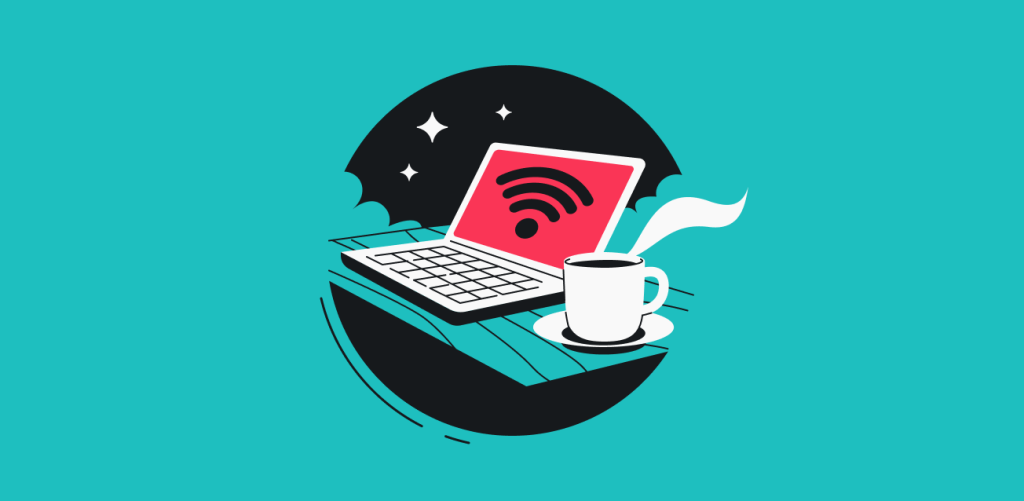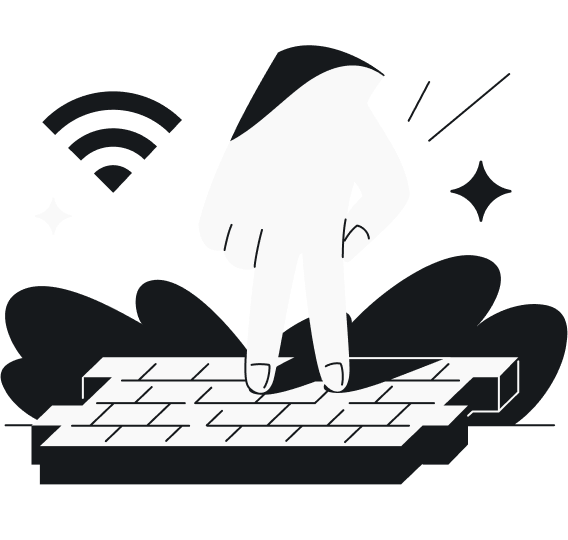
All public places are expected to have a Wi-Fi hotspot nowadays. Without free Wi-Fi, the customers of an independent coffee shop would quickly roll up their last cigarette and leave. The convenience is lovely — but you need to be cautious! Public Wi-Fi comes with a whole slew of cybersecurity risks.
Table of contents
What are the dangers of public Wi-Fi?
Public Wi-Fi networks are not as safe as your home Wi-Fi. This is less than ideal, considering everyone is constantly connecting to them — hackers included. Bad actors often join such unsecured Wi-Fi networks with malicious intent, and there are multiple ways in which they can harm you.
Malware infections
Hackers can install malware straight onto a public Wi-Fi hotspot, which then spreads to connected devices. This is made possible because of software vulnerabilities. It can also spread through malicious ads or pop-ups, which install malware once clicked.
Most likely, you won’t even notice the malicious software. In the meantime, the hacker could collect sensitive data, access your files, or render your device unusable.
Man-in-the-Middle attacks
Man-in-the-Middle (MITM) attacks are fairly easy to pull off with free Wi-Fi hotspots. Normally, your data travels from your device to the website you’re visiting via the Wi-Fi router (and the rest of the internet infrastructure). A hacker steps in the middle of this connection by compromising the router, hence the name. When this happens, everything you do online is served on a platter to whoever is intercepting the connection.
Once again, you would remain completely unaware, all while the hacker steals your passwords and information. The results of such attacks may vary from simple snooping to theft of your banking details or credit card information.
Malicious hotspots
When they’re not trying to break established Wi-Fi networks, cybercriminals set up their own hotspots. Also known as evil twin attacks, malicious hotspots are made to look like legitimate sources of free Wi-Fi.
Hackers typically give unassuming names to such networks, like “Free Wi-Fi” or “[name of local business] Guest Wi-Fi.” Very conveniently, they rarely require a password, making it easy for you to connect. Once online, your information flows straight to the cybercriminal behind the network.
Snooping and sniffing
Hackers can get your data even without directly accessing your device. They can infiltrate unsecured public Wi-Fi networks using special software.
As the name suggests, they snoop on your data, looking for anything that could benefit them. Login details, credit card information, and other sensitive data are their favorite targets. Needless to say, the results are often very costly for those affected.
Unencrypted networks
Most routers nowadays have encryption capabilities. However, it needs to be enabled through router settings, as encryption is turned off by default. Not everyone knows about this, so public Wi-Fi networks are often left unencrypted, creating new security risks.
An encrypted network turns your traffic into code. Cracking this code is still possible but requires much more effort than is practically possible. An unencrypted network does nothing to protect your connection. Hackers can access information on such networks effortlessly and then use it for MITM attacks and other criminal activities.

How to stay safe on public Wi-Fi
Considering all the risks associated with using public Wi-Fi, is there any way to use such networks safely? While there is no way to ensure 100% protection whenever you’re online, there are some things you can do to make public Wi-Fi connections safe.
Avoid accessing sensitive information
You shouldn’t do banking on public Wi-Fi, but that’s not the only way you can potentially expose your sensitive data. Don’t log into any of your government service-related profiles, health service portals, and so on.
Use a VPN
A VPN (Virtual Private Network) should be your primary safety tool whenever you’re online. It encrypts all your traffic before it leaves your device, keeping it safe from prying eyes. This way, your public Wi-Fi connection becomes a lot more secure.
Clear your cache and browsing history
Bad actors may be snooping on your browsing history and cache, looking for sensitive information. Therefore, it’s best to clear it all before connecting to an unsecured network to avoid raising any more security risks.
Turn off auto-connect
Chances are that the auto-connect feature is active on your device. While very convenient, it can become a weak point in your online security. For your own safety, it’s better to keep your Wi-Fi off when you’re not using it.
Log out of your accounts
Once you’re done using public Wi-Fi, log out of any services you were using. At the same time, you should also make your device forget the Wi-Fi network in question so it wouldn’t automatically connect to it the next time.
Use 2FA
Two-factor authentication, or 2FA, is a great way to add an extra layer of security to your logins. That way, the hackers may be unable to connect to your accounts, even if they steal your login details.
Don’t use the same password everywhere
Yet another general security tip. Don’t use the same password on all of your online accounts. That’s just you making the hacker’s job easy. Switch it up and use different secure passwords on your accounts.
Update your software
When software has security loopholes or bugs, its developers make updates to fix them. For the best chance at security, make sure your OS and apps are always up to date.
Use antivirus software
Although you should always use antivirus software, it’s even more important on unsecured networks. Hackers might try to slip malware into your device, and antivirus can be the difference between staying safe or losing control over your phone or computer.
Disable file sharing
With file sharing on, anyone connected to the same public Wi-Fi network can easily access your files. Turn this setting off unless you want to share your files with cybercriminals.
Signs of an unsafe Wi-Fi network
Unfortunately, it can be hard to tell a safe network from one that can end up harming you. However, there are some red flags that you should look out for:
- Does the network have a password?
Most establishments have Wi-Fi nowadays but they tend to protect it with a password. A public Wi-Fi hotspot without a password does not mean it’s unsafe. But you definitely should be cautious connecting to such networks;
- Does the name look trustworthy?
Malicious hotspots commonly have two name types. Some are very general, such as “Free Wi-Fi,” “Hotel guest,” etc. Others try to copy the names of established networks. If you feel even a pinch of doubt about the name, stay away;
- Can you connect to HTTPS websites?
HTTPS means that a website has an active SSL certificate. If a network is affected by a MITM attack, all websites may load as HTTP rather than HTTPS. Always double-check if the websites you visit load as HTTPS. If they don’t, disconnect from the Wi-Fi network immediately.
In conclusion: it’s possible to be safe on public Wi-Fi networks
If you take your cybersecurity seriously, safe use of free Wi-Fi is possible. Just make sure to use all of the tips above to secure your data and avoid being fooled by a devil in disguise.
FAQ
Is it ever safe to use public Wi-Fi?
You are never 100% safe on a public Wi-Fi network. But there are things you can do to significantly improve your safety on free Wi-Fi:
- Use a VPN;
- Clear your cache and browsing history;
- Turn off auto-connect;
- Log out of your accounts;
- Use 2FA;
- Don’t use the same password everywhere;
- Update your software;
- Use antivirus software;
- Disable file sharing;
- Use a mobile hotspot.
What should you not do on public Wi-Fi?
When using public Wi-Fi, you shouldn’t:
- Access bank accounts or sensitive personal data;
- Do online shopping.
Is it safe to use Wi-Fi at a hotel?
Hotel Wi-Fi, like all public Wi-Fi, is not very safe, even when at a hotel that uses a secure connection. Always use a VPN, just in case.
Is it safe to use public Wi-Fi for banking?
No, it’s not safe to do banking on public Wi-Fi. The same goes for online shopping, making payments, or any other activity requiring sensitive information.
No matter how many safety precautions you take, it’s best to do these things on your home network.
What are the security risks of using public Wi-Fi?
There are quite a few risks associated with public Wi-Fi. They all include hackers trying to access and steal your precious personal information. Here are the most common ones:
- Malware infections;
- Man-in-the-Middle attacks;
- Malicious hotspots;
- Snooping and sniffing;
- Unencrypted networks.



